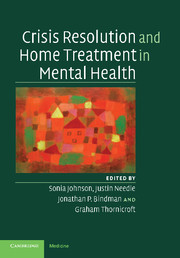Book contents
- Frontmatter
- Contents
- List of contributors
- Foreword
- Acknowledgements
- Section 1 Introduction and concepts
- Section 2 The evidence
- Section 3 Current practice
- Section 4 Variations and enhancements
- 19 Integration of the crisis resolution function within community mental health teams
- 20 Home treatment and ‘hospitality’ within a comprehensive community mental health centre
- 21 Crisis resolution teams and older people
- 22 Integrating day treatment and crisis resolution teams
- 23 Integrating crisis residential care and crisis resolution teams
- Section 5 Developing a local service
- Index
- References
22 - Integrating day treatment and crisis resolution teams
from Section 4 - Variations and enhancements
Published online by Cambridge University Press: 13 August 2009
- Frontmatter
- Contents
- List of contributors
- Foreword
- Acknowledgements
- Section 1 Introduction and concepts
- Section 2 The evidence
- Section 3 Current practice
- Section 4 Variations and enhancements
- 19 Integration of the crisis resolution function within community mental health teams
- 20 Home treatment and ‘hospitality’ within a comprehensive community mental health centre
- 21 Crisis resolution teams and older people
- 22 Integrating day treatment and crisis resolution teams
- 23 Integrating crisis residential care and crisis resolution teams
- Section 5 Developing a local service
- Index
- References
Summary
For some patients, the provision of home-based treatment from a crisis resolution team (CRT) will not be an adequate or safe alternative to admission. Realistically, two or three hour-long home visits per day are the maximum that a busy CRT can provide on a regular basis. Hoult (1986) described an Australian service where, as a pragmatic measure, a patient could accompany a clinician travelling over long distances to the next home visit as a way of providing increased supervision and support. This, however, is not the norm in the UK. Home-based treatment must be flexible in order to meet the patient's needs, but resources are necessarily finite. Occasional longer visits from a support worker are useful but cannot be seen as a sustainable intervention. One could argue that if a patient cannot be contained or provided with sufficient support by home-based treatment then admission should be sought. This is often the case, but while admission should certainly not be avoided at all cost, there are circumstances in which alternatives are preferable. One potential way of bridging the gap between home-based treatment and admission is to use an acute day service or a partial hospitalisation programme as an element in CRT service provision.
Acute day hospitals to which patients can be admitted urgently as a substitute for inpatient care have a long history, dating back to the USSR in the 1930s. The 1970s were probably the time of their peak popularity in Western countries (Shepherd, 1991).
- Type
- Chapter
- Information
- Crisis Resolution and Home Treatment in Mental Health , pp. 275 - 282Publisher: Cambridge University PressPrint publication year: 2008

